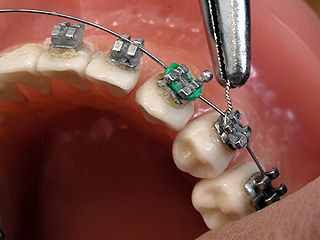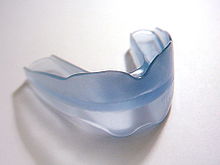Design and operation
The device is made from flexible material as one single piece. At its center, it is completely even and approximates the shape of an ideal dental arch. This flat part is surrounded by ramp-shaped walls. The teeth of the upper and lower jaw bite into the space between these walls accordingly. Normally, there are no individual tooth slots, with the prominent exception of the Australian Myobrace design.
The appliance sits passively between the upper and lower jaw, and does not exercise any force by itself to the teeth. When the patient bites together, the teeth standing out of line collide with ramp-shaped walls and are moved into their correct position over time. This works due to the principle of the inclined plane and the spring force of the elastic deformation of the device. By biting more or less intensively, the patient can determine themselves how much force is applied.
When the appliance is worn, the lower jaw is positioned into Angle class 1 relation towards the upper jaw. This is supposed to get the jaw muscles used to this position, and to let the patient learn the correct swallowing pattern. The teeth that in this jaw position do not reach the central plane are allowed to erupt, the same way as they would do with a bite-plate applied.
There are special modifications for the treatment of overbite and underbite, however they usually only differ in the shape of the dental arch and in stronger or longer walls.
The device has to be worn at night as well as one hour during daytime. The effect can be increased by doing bite exercises during this time. The wearing comfort is pretty high, however talking is completely impossible. In order to wear the device the patient must be able to breathe through the nose. During the first days, it can fall out of the mouth.
As with any intra-oral appliance, wearing it should not cause sore spots on the gingiva, as this could lead to permanent tissue damage. If it does cause sores, the parts of the device causing the damage have to be cut off as soon as possible.

Bruxism is excessive teeth grinding or jaw clenching. It is an oral parafunctional activity; i.e., it is unrelated to normal function such as eating or talking. Bruxism is a common behavior; reports of prevalence range from 8% to 31% in the general population. Several symptoms are commonly associated with bruxism, including aching jaw muscles, headaches, hypersensitive teeth, tooth wear, and damage to dental restorations. Symptoms may be minimal, without patient awareness of the condition. If nothing is done, after a while many teeth start wearing down until the whole tooth is gone.

Orthodontics is a dentistry specialty that addresses the diagnosis, prevention, management, and correction of mal-positioned teeth and jaws, as well as misaligned bite patterns. It may also address the modification of facial growth, known as dentofacial orthopedics.

Dental braces are devices used in orthodontics that align and straighten teeth and help position them with regard to a person's bite, while also aiming to improve dental health. They are often used to correct underbites, as well as malocclusions, overbites, open bites, gaps, deep bites, cross bites, crooked teeth, and various other flaws of the teeth and jaw. Braces can be either cosmetic or structural. Dental braces are often used in conjunction with other orthodontic appliances to help widen the palate or jaws and to otherwise assist in shaping the teeth and jaws.

A mouthguard is a protective device for the mouth that covers the teeth and gums to prevent and reduce injury to the teeth, arches, lips and gums. An effective mouthguard is like a crash helmet for teeth and jaws. It also prevents the jaws coming together fully, thereby reducing the risk of jaw joint injuries and concussion. A mouthguard is most often used to prevent injury in contact sports, as a treatment for bruxism or TMD, or as part of certain dental procedures, such as tooth bleaching or sleep apnea treatment. Depending on the application, it may also be called a mouth protector, mouth piece, gumshield, gumguard, nightguard, occlusal splint, bite splint, or bite plane. The dentists who specialise in sports dentistry fabricate mouthguards.

A mandibi splint or mandibi advancement splint is a prescription custom-made medical device worn in the mouth used to treat sleep-related breathing disorders including: obstructive sleep apnea (OSA), snoring, and TMJ disorders. These devices are also known as mandibular advancement devices, sleep apnea oral appliances, oral airway dilators, and sleep apnea mouth guards.

Orthodontic headgear is a type of orthodontic appliance typically attached to the patient's head with a strap or number of straps around the patient's head or neck. From this, a force is transferred to the mouth/jaw(s) of the subject.
The Nociceptive trigeminal inhibition tension suppression system, is a type of occlusal splint that is claimed to prevent headache and migraine by reducing sleep bruxism. Sleep bruxism is purported to lead to a hyperactivity of the trigeminal nerve, often triggering typical migraine events. The hyperactivity of trigeminal neurons during trigemino-nociceptive stimulation is a proposed cause of migraine and is correlated with imaging of migraine sufferers. The objective of the NTI-TSS is to relax the muscles involved in clenching and bruxing, thus supposedly diminishing the chances for migraines and tension headaches to develop through the reduction in nociceptive stimulation normally caused by parafunctional activity. It is sometimes used for temporomandibular joint dysfunction (TMD).

In orthodontics, a malocclusion is a misalignment or incorrect relation between the teeth of the upper and lower dental arches when they approach each other as the jaws close. The English-language term dates from 1864; Edward Angle (1855-1930), the "father of modern orthodontics", popularised it. The word "malocclusion" derives from occlusion, and refers to the manner in which opposing teeth meet.

A palatal expander is a device in the field of orthodontics which is used to widen the upper jaw (maxilla) so that the bottom and upper teeth will fit together better. This is a common orthodontic procedure. Although the use of an expander is most common in children and adolescents 8–18 years of age, it can also be used in adults, although expansion is slightly more uncomfortable and takes longer. A patient who would rather not wait several months for the end result by a palatal expander may be able to opt for a surgical separation of the maxilla. Use of a palatal expander is most often followed by braces to then straighten the teeth.
Orthodontic technology is a specialty of dental technology that is concerned with the design and fabrication of dental appliances for the treatment of malocclusions, which may be a result of tooth irregularity, disproportionate jaw relationships, or both.
Jaw wiring is a medical procedure to keep the jaw closed for a period of time. Originally, it was used as the mandibular equivalent of a cast, to fix the jaw in place while a fracture healed. Jaw wiring is also used for weight-loss purposes, to prevent the ingestion of solid food.
Macrodontia is a type of localized gigantism in which teeth are larger than normal. Macrodontia seen in permanent teeth is thought to affect around 0.03 to 1.9 percent of the worldwide population. Generally, patients with macrodontia have one or two teeth in their mouth that is abnormally large; however, single tooth growth is seen in a number of cases as well.

Dental attrition is a type of tooth wear caused by tooth-to-tooth contact, resulting in loss of tooth tissue, usually starting at the incisal or occlusal surfaces. Tooth wear is a physiological process and is commonly seen as a normal part of aging. Advanced and excessive wear and tooth surface loss can be defined as pathological in nature, requiring intervention by a dental practitioner. The pathological wear of the tooth surface can be caused by bruxism, which is clenching and grinding of the teeth. If the attrition is severe, the enamel can be completely worn away leaving underlying dentin exposed, resulting in an increased risk of dental caries and dentin hypersensitivity. It is best to identify pathological attrition at an early stage to prevent unnecessary loss of tooth structure as enamel does not regenerate.

Overjet is the extent of horizontal (anterior-posterior) overlap of the maxillary central incisors over the mandibular central incisors. In class II malocclusion the overjet is increased as the maxillary central incisors are protruded.

Crossbite is a form of malocclusion where a tooth has a more buccal or lingual position than its corresponding antagonist tooth in the upper or lower dental arch. In other words, crossbite is a lateral misalignment of the dental arches.
The Dahl effect or Dahl concept is used in dentistry where a localized appliance or localized restoration is used to increase the available interocclusal space for restorations.

Tooth mobility is the horizontal or vertical displacement of a tooth beyond its normal physiological boundaries around the gingival area, i.e. the medical term for a loose tooth.
Activator Appliance is an Orthodontics appliance that was developed by Viggo Andresen in 1908. This was one of the first functional appliances that was developed to correct functional jaw in the early 1900s. Activator appliance became the universal appliance that was used widely throughout Europe in the earlier part of the 20th century.
Open bite is a type of orthodontic malocclusion which has been estimated to occur in 0.6% of the people in the United States. This type of malocclusion has no vertical overlap or contact between the anterior incisors. The term "open bite" was coined by Carevelli in 1842 2 as a distinct classification of malocclusion. Different authors have described the open bite in a variety of ways. Some authors have suggested that open bite often arises when overbite is less than the usual amount. Additionally, others have contended that open bite is identified by end-on incisal relationships. Lastly, some researchers have stated that a lack of incisal contact must be present to diagnose an open bite.













